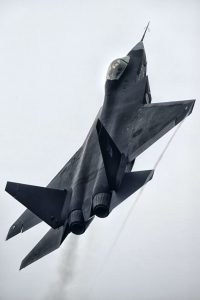China’s J-31 Falcon-Hawk Stealth Fighter
First shown in 2012 at the China Aviation and Aerospace Exhibition with a ¼ scale model, the J-31 Falcon-Hawk appears, at first glance, to be China’s answer to America’s new F-35 Joint Strike Fighter (JSF). It is a stealthy, single seat, twin engine, twin tail, aircraft with a maximum speed of Mach 1.8, and carries both short and medium range air-to-air missiles.
Although the Aviation Industry Corporation of China (AVIC) has suggested that they are marketing the airframe to the Chinese Air Force, the company has also made it clear that the aircraft was developed for export (potentially as a cheaper alternative for nations unable to purchase the F-35) with an expected first flight for production models in 2019.
Performance & Power:
The 17.3 meters (56 feet 9 inches) long, J-31 prototypes have a wingspan of 37 feet 9 inches and currently use two Russian RD-93 engines. These afterburning turbofans produce 19,000 foot pounds of thrust. However, it’s expected that AVIC may move to utilizing the Chinese WS-13A engine, which would increase the thrust to 22,000 foot pounds.

Speed:
Currently, the J-31 has a maximum speed of Mach 1.8 and a combat range of 1,201 kilometers (746 miles). It has a gross weight of 38,801 pounds and a maximum takeoff weight of 28,000 kilograms (61,729 pounds), requiring takeoff and landing distances of 400 and 600 meters, respectively.
As the aircraft is currently still in production, it remains to be seen the true limits of its performance potential.

Stealth Components:
The J-31’s design seeks to combine stealth characteristics with conventional fighter versatility. The aircraft has both a stealth oriented aerodynamic design and stealth technology coating. It also includes divertless supersonic inlet bumps and forward swept intake ramps.
These help eliminate radar reflections between the diverter and aircraft’s skin, and reduce the engine’s exposure to radar. The J-31 is purported to be stealthy against L-band and Ku-band radars, with low observability against a number of multi spectrum sensors.
Weapon Integration Systems:
The J-31 has a payload of 17,737 pounds with four munitions (totaling 4,409 pounds) internally, and 13,228 pounds carried on six external hard points. These hard points are closer to the aircraft’s center of gravity, thanks to its aft-tail layout, which make it easier to conduct maneuvers while under load.
Its primary weapons include the PL-9 short range missile and the SD-10A medium range air-to-air missile.

Future Development:
From its first appearance at China’s Aviation and Aerospace Exhibition in 2012, the J-31 has been promoted as an export model. During the 2015 Dubai Airshow, AVIC revealed they are looking for a partner in manufacturing, but were actively marketing to the Chinese Air Force. The Chinese military, conversely, appears to want nothing to do with the aircraft.

Cost & Controversy:
The J-31 is marketed, albeit unofficially, as a cheaper alternative to America’s F-35. At first glance, it appears to be a twin-engine copy of the Joint Strike Fighter and some in the U.S avionics community believe it was designed, in part, from stolen JSF technology.
Furthermore, AVIC president Lin Zuoming stated in an interview with China Central Television that the “the opponent model” was taken into consideration when designing the J-31 and that it “should be able to take [the opponent model] down when it takes the sky.”
Shenyang Aircraft Corporation, the makers of the J-31, have denied these claims, however. Regardless of whether or not competition with the F-35 was intended, this marketing appears to be working. Soon after the 2015 Dubai Airshow, Pakistan began talks to purchase 30-40 models from China.
Obstacles:
While this bodes well for AVIC, there are potential pitfalls. The current prototype models carry the Russian RD-93 engine. Should AVIC seek to export the aircraft in large quantities, they need to transition from the Russian engine to a Chinese one (most likely the WS-13A), thereby eliminating the possibility of Russian control over production numbers.
The current J-31’s are also believed to be fairly bare-bones airframes, lacking the sophisticated sensor and electro-optical technology present in Gen-5 aircraft. It is believed that whoever partners with AVIC for development and would assist with the completion of these features.
While it remains to be seen how the J-31 will perform in the international defense market, AVIC remains hopeful and confident in their new stealth fighter.
| Length: 17.3 m (56 ft 9 in) |
| Height: 4.8 m (15 ft 9 in) |
| Weight: 17,600 kg (38,801 lbs) |
| Wingspan: 11.5 m (37 ft 9 in) |
| Wing Area: 40 sqm (430 sq ft) |
| Maximum Speed: 2,200 km/h (1,367 mph; 1,188 kn) |
| Powerplant: 2 × RD-93 afterburning turbofans, 85 kN (19,000 lbf) thrust each |
| Maximum Takeoff Weight: 28,000 kg (61,729 lb) |
| Crew: 1 |
| Combat Range: 1,201 km (746 mi) on internal fuel, or 2,000 km (1,243 mi) with external tanks |
| *Because the aircraft is in development, these specifications — based on available imagery — are approximate and preliminary. |

